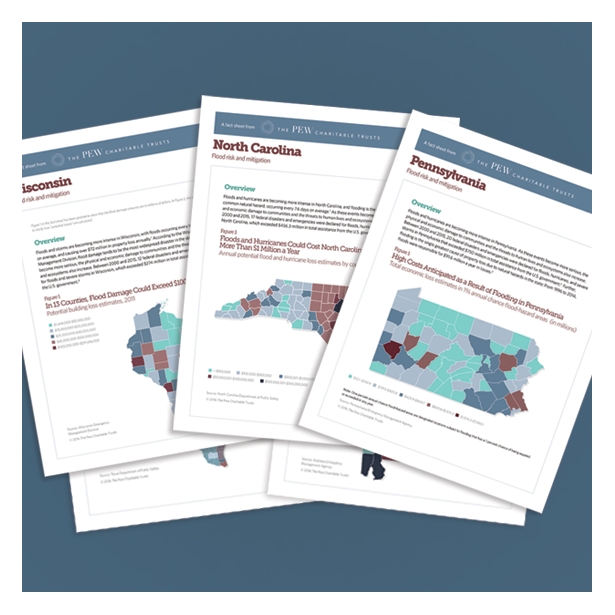New York
Flood risk and mitigation
Natural disasters are a serious threat to New York, causing loss of life and considerable physical and economic damage to communities. Between 2000 and 2017, 23 federal disasters were declared for floods, hurricanes, and severe storms in the state, costing taxpayers billions in assistance.1
Federal flood insurance helps communities prepare
In New York, 35 localities participate in the National Flood Insurance Program’s Community Rating System. This voluntary program offers communities lower insurance premiums if they have flood plain management practices that exceed the program’s minimum requirements. These practices include buying out flood-prone homes, improving storm drainage, elevating buildings, and floodproofing structures. The town of Greece has taken advantage of this program and earned a Community Rating System designation of 6, the highest in the state. This has garnered policyholders living in a designated flood zone a 20 percent discount on flood insurance premiums.2
Mitigation pays in New York
The National Institute of Building Sciences recently found that investment in mitigation, including through programs like FEMA’s Pre-Disaster Mitigation Program and Hazard Mitigation Grant Program, saves society $6 for every $1 spent. In the most flood-prone parts of New York, building two feet higher than the code requirement returns $6.70 for every $1 invested.3
Importance of policy
Communities must take action to better prepare for weather-related catastrophes such as floods. And federal officials should consider policy reforms that would improve flood protection and preparation, minimize disruptions to the economy, and reduce costs to federal and state taxpayers. These actions include:
- Increasing federal investment in flood mitigation programs that help communities prepare for and reduce the damage from floods.
- Improving resiliency requirements for infrastructure built and rebuilt in flood-prone areas.
- Protecting ecosystems such as wetlands, salt marshes, and dunes that can act as barriers to storms and help shield property.
- Reforming the National Flood Insurance Program to better communicate actual risk, break the cycle of repeated loss and rebuilding in the most flood-prone areas, and provide incentives to compel communities and homeowners to better prepare for floods.
Endnotes
- Federal Emergency Management Agency, “Disasters: Total Number of Declared Disasters by State/Tribal Government and by Year,” accessed March 19, 2018, https://www.fema.gov/disasters.
- Federal Emergency Management Agency, “Community Rating System” (2017), https://www.fema.gov/media-library-data/1523648898907-9056f549d51efc72fe60bf4999e904a/20_crs_508_apr2018.pdf.
- National Institute of Building Sciences, “Natural Hazard Mitigation Saves: 2017 Interim Report” (2017), https://www.nibs.org/page/mitigationsaves. This finding refers to new buildings in coastal velocity zones, the most hazardous of the special flood hazard areas.












